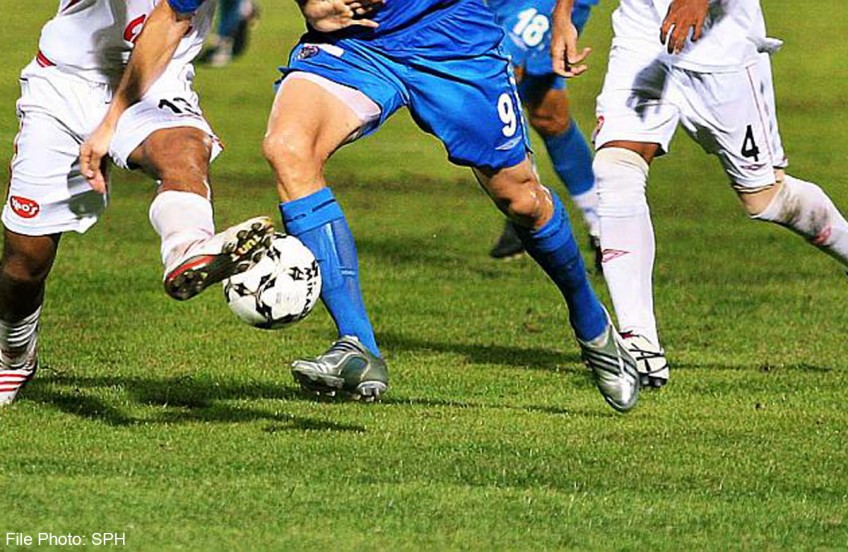Mad about football? How to avoid injuries from contact sports


At least four in 10 people here play sports, including contact sports such as football, basketball, hockey and rugby, according to Singapore's Vision 2030 sports masterplan.
Aside from common overuse injuries, sports that require lots of contact between players or players and objects can potentially increase the rate of injury because of their physicality, say doctors and physiotherapists.
It is a good idea to get checked before starting a contact sport regimen, said Ms Khoo Shin Jiun, a senior physiotherapist at Singapore General Hospital (SGH). This will give you a picture of what you can and cannot do.
Your doctor will take your medical history to identify any "red flags" that need further investigation, said Dr Poh Seng Yew, a consultant in the department of orthopaedic surgery at SGH.
For sporting purposes, this means any previous muscle, joint or ligament injuries, fractures, concussions or spinal injuries, how they were treated and what the recovery process was like, he said.
Your doctor will also test how strong your heart and lungs are.
"We ask for cardiac symptoms such as chest pain, shortness of breath, dizziness or fainting spells," said Dr Poh.
Aside from that, your doctor will want to know your cardiovascular risk factors, such as your personal history of hypertension, diabetes, and heart disease, as well as any family history of heart disease, respiratory disease and asthma.
A sports physical test will tell your doctor if you can play a contact sport, or if you need special restriction of activities instead, said Dr Poh.
Contact sports are demanding, requiring cardiovascular fitness, agility, speed, strength, power and flexibility.
Ms Khoo said the test gives doctors a baseline for each component from which coaches or physiotherapists can start recommending an individualised programme.
So be prepared for a full body examination, which may entail physical tests to assess how efficiently you use oxygen during exercise as well as your flexibility, agility and strength.
What your maximum intake of oxygen during exercise is can be measured by a treadmill VO2 max test.
The hamstring muscles and calves are needed in running, sprinting, jumping and kicking and a simple "sit and reach" test measures how flexible they are.
Strength is measured through a one repetition maximum (1RM) test, which ascertains the maximum amount of weight one can lift in a single repetition for a given exercise, said Ms Khoo.
For example, in a squat or bench press, the maximum weight that a person can lift with his hands or legs in a single repetition is measured.
The muscle strength of each individual muscle is crucial as it serves as a foundation for power generation, agility and stamina, said Ms Khoo.
This may be the most important or telling test for contact sports such as football.
FIT TO A 'T'
An evaluation of leg power can show a person's muscular ability to generate power, which is a key element of success in football.
In that game, a typical sequence of movements is running, dribbling and kicking the ball, which will need a high speed of release or impact.
Testing the maximum strength of the lower limbs allows for more precise strength training for those who want to play football, said Ms Khoo.
But also important in a contact sport is agility in changing directions and play, as well as avoiding the unexpected.
The T-test is used to measure this. The athlete begins with both feet behind a starting line. When he is ready, he sprints forward 5m to a cone and touches the base with his right hand.
Facing forward and without crossing his feet, he shuffles 5m to the left to touch the base of another cone with his left hand.
Then he shuffles to the right to touch the base of a third cone, 10m away from the second cone, with his right hand.
Finally, he shuffles back to the first cone, touches its base and runs backward as quickly as possible to the starting line.
The test is repeated if he crosses one foot in front of the other, does not touch the base of a cone or fails to face forward.
These tests are normally carried out by physiotherapists, who will be able to interpret and explain the results.
WEEKEND WARRIOR, BEWARE
But merely getting a sports physical test, while a good first step, cannot prevent injuries.
Anyone who is not in good condition and suddenly increases the intensity of exercise - the so-called weekend warrior - is in danger of getting injured.
Dr Poh said the most common are muscle strains especially in the quadriceps or hamstrings, or ligament sprains such as in the ankle or knee.
A period of rest followed by a structured rehabilitation programme is usually enough for recovery, he added.
Without the adequate rest and recovery, more serious injuries can result, such as cruciate ligament tears or meniscus tears in the knee, labral tears in the shoulder or hip, or bone fractures.
The sufferer can usually tell because of the terrible pain, deformity or joint instability that results, and they need to be evaluated and treated by an orthopaedic surgeon, warned Dr Poh.
Muscle stretching, strengthening programmes and postural balance and training may help to reduce joint sprains, he said.
Sport-specific drills that simulate match conditions are useful in conditioning the muscle and joint towards the required activity, such as ball handling, shooting, passing and tackling, he added.
For the match itself, it is important to ensure the person does adequate warm-up exercises and wears protective gear such as pads, knee and shin guards and special shoes with cleats.
More importantly, the person should never play when he is injured, as the likelihood of getting hurt again is much higher, said Dr Poh.
This article was published on May 15 in Mind Your Body, The Straits Times.

Get a copy of Mind Your Body, The Straits Times or go to straitstimes.com for more stories.